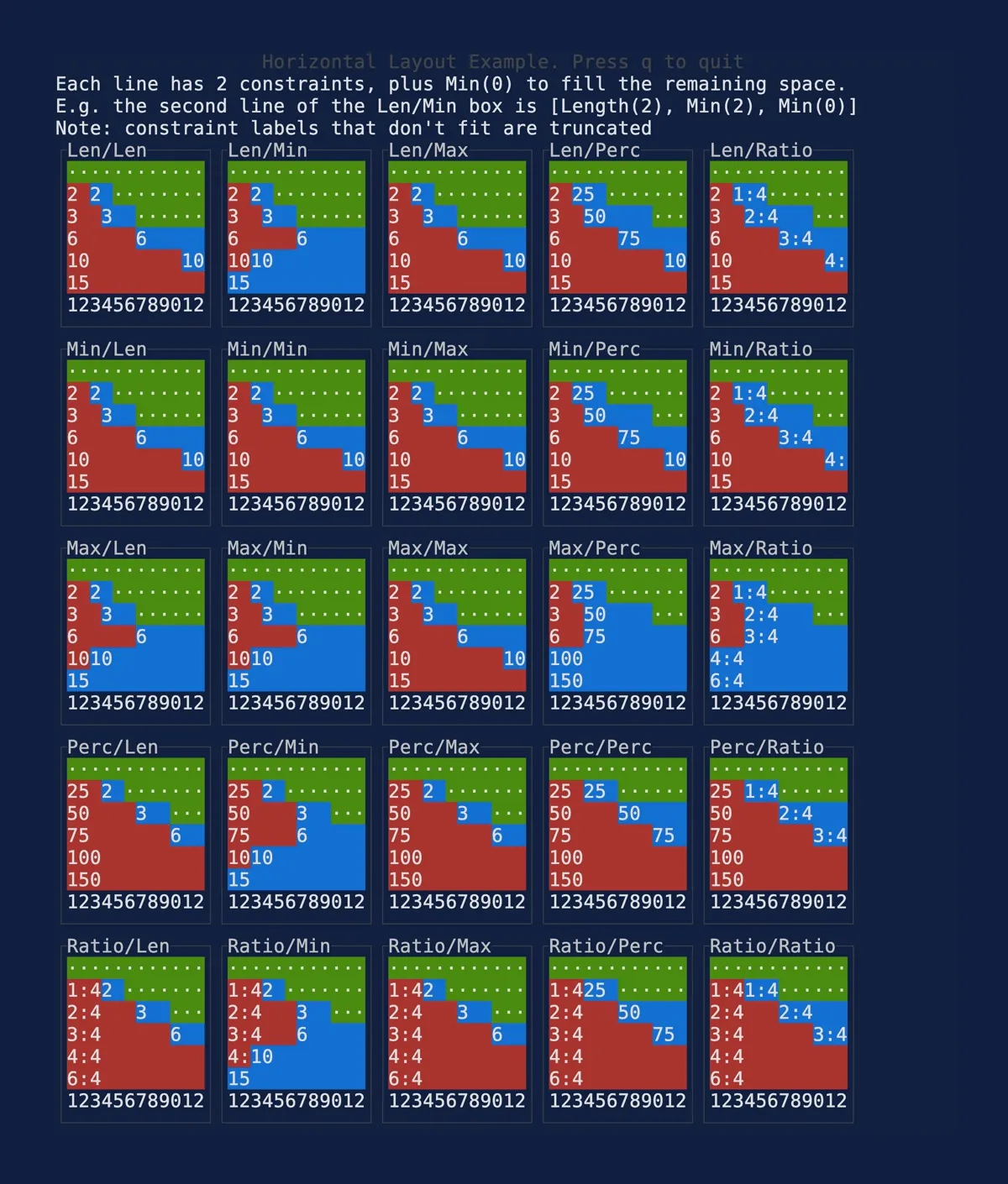Layout
Demonstrates the Layout.
git clone https://github.com/ratatui/ratatui.git --branch latestcd ratatuicargo run --example=layout --features=crossterm
//! # [Ratatui] Layout example//!//! The latest version of this example is available in the [examples] folder in the repository.//!//! Please note that the examples are designed to be run against the `main` branch of the Github//! repository. This means that you may not be able to compile with the latest release version on//! crates.io, or the one that you have installed locally.//!//! See the [examples readme] for more information on finding examples that match the version of the//! library you are using.//!//! [Ratatui]: https://github.com/ratatui/ratatui//! [examples]: https://github.com/ratatui/ratatui/blob/main/examples//! [examples readme]: https://github.com/ratatui/ratatui/blob/main/examples/README.md
use itertools::Itertools;use ratatui::{ crossterm::event::{self, Event, KeyCode, KeyEventKind}, layout::{ Constraint::{self, Length, Max, Min, Percentage, Ratio}, Layout, Rect, }, style::{Color, Style, Stylize}, text::Line, widgets::{Block, Paragraph}, DefaultTerminal, Frame,};
fn main() -> color_eyre::Result<()> { color_eyre::install()?; let terminal = ratatui::init(); let app_result = run(terminal); ratatui::restore(); app_result}
fn run(mut terminal: DefaultTerminal) -> color_eyre::Result<()> { loop { terminal.draw(draw)?; if let Event::Key(key) = event::read()? { if key.kind == KeyEventKind::Press && key.code == KeyCode::Char('q') { break Ok(()); } } }}
#[allow(clippy::too_many_lines)]fn draw(frame: &mut Frame) { let vertical = Layout::vertical([ Length(4), // text Length(50), // examples Min(0), // fills remaining space ]); let [text_area, examples_area, _] = vertical.areas(frame.area());
// title frame.render_widget( Paragraph::new(vec![ Line::from("Horizontal Layout Example. Press q to quit".dark_gray()).centered(), Line::from("Each line has 2 constraints, plus Min(0) to fill the remaining space."), Line::from("E.g. the second line of the Len/Min box is [Length(2), Min(2), Min(0)]"), Line::from("Note: constraint labels that don't fit are truncated"), ]), text_area, );
let example_rows = Layout::vertical([ Length(9), Length(9), Length(9), Length(9), Length(9), Min(0), // fills remaining space ]) .split(examples_area); let example_areas = example_rows.iter().flat_map(|area| { Layout::horizontal([ Length(14), Length(14), Length(14), Length(14), Length(14), Min(0), // fills remaining space ]) .split(*area) .iter() .copied() .take(5) // ignore Min(0) .collect_vec() });
// the examples are a cartesian product of the following constraints // e.g. Len/Len, Len/Min, Len/Max, Len/Perc, Len/Ratio, Min/Len, Min/Min, ... let examples = [ ( "Len", [ Length(0), Length(2), Length(3), Length(6), Length(10), Length(15), ], ), ("Min", [Min(0), Min(2), Min(3), Min(6), Min(10), Min(15)]), ("Max", [Max(0), Max(2), Max(3), Max(6), Max(10), Max(15)]), ( "Perc", [ Percentage(0), Percentage(25), Percentage(50), Percentage(75), Percentage(100), Percentage(150), ], ), ( "Ratio", [ Ratio(0, 4), Ratio(1, 4), Ratio(2, 4), Ratio(3, 4), Ratio(4, 4), Ratio(6, 4), ], ), ];
for ((a, b), area) in examples .iter() .cartesian_product(examples.iter()) .zip(example_areas) { let (name_a, examples_a) = a; let (name_b, examples_b) = b; let constraints = examples_a.iter().copied().zip(examples_b.iter().copied()); render_example_combination(frame, area, &format!("{name_a}/{name_b}"), constraints); }}
/// Renders a single example boxfn render_example_combination( frame: &mut Frame, area: Rect, title: &str, constraints: impl ExactSizeIterator<Item = (Constraint, Constraint)>,) { let block = Block::bordered() .title(title.gray()) .style(Style::reset()) .border_style(Style::default().fg(Color::DarkGray)); let inner = block.inner(area); frame.render_widget(block, area); let layout = Layout::vertical(vec![Length(1); constraints.len() + 1]).split(inner); for ((a, b), &area) in constraints.into_iter().zip(layout.iter()) { render_single_example(frame, area, vec![a, b, Min(0)]); } // This is to make it easy to visually see the alignment of the examples // with the constraints. frame.render_widget(Paragraph::new("123456789012"), layout[6]);}
/// Renders a single example linefn render_single_example(frame: &mut Frame, area: Rect, constraints: Vec<Constraint>) { let red = Paragraph::new(constraint_label(constraints[0])).on_red(); let blue = Paragraph::new(constraint_label(constraints[1])).on_blue(); let green = Paragraph::new("·".repeat(12)).on_green(); let horizontal = Layout::horizontal(constraints); let [r, b, g] = horizontal.areas(area); frame.render_widget(red, r); frame.render_widget(blue, b); frame.render_widget(green, g);}
fn constraint_label(constraint: Constraint) -> String { match constraint { Constraint::Ratio(a, b) => format!("{a}:{b}"), Constraint::Length(n) | Constraint::Min(n) | Constraint::Max(n) | Constraint::Percentage(n) | Constraint::Fill(n) => format!("{n}"), }}
